An aquatic plant was placed in a test tube containing water. The tube was then stopered and left outdoors for 24 hours. The pH value of water was measured at regular intervals. What must have been the result?
pH value was the lowest just before sunrise
pH value was the highest iust before sunrise
pH value was the lowest at noon
pH value was the lowest just before sunset
The correct Answer is:A
To solve the question regarding the pH value of water in a test tube containing an aquatic plant left outdoors for 24 hours, we can follow these steps:
1. Understanding Photosynthesis:
- Aquatic plants perform photosynthesis, which is the process of converting carbon dioxide and water into glucose and oxygen using sunlight. This process affects the pH of the water.
2. Initial Conditions:
- When the aquatic plant is placed in the test tube, it is likely to have some dissolved carbon dioxide (CO2) in the water, which can lower the pH, making it more acidic.
3. Daylight Influence:
- During the day, particularly after sunrise, the plant will utilize sunlight to perform photosynthesis. This process consumes carbon dioxide, which will lead to a decrease in the concentration of CO2 in the water.
4. pH Changes Over Time:
- Just before sunrise, the plant has not yet begun photosynthesis, and the concentration of CO2 is relatively high, resulting in a lower pH (more acidic).
- After sunrise, as photosynthesis begins, CO2 is consumed, leading to an increase in pH (making it less acidic or more alkaline).
5. Conclusion:
- Therefore, the pH of the water will be lowest just before sunrise due to the accumulation of CO2 overnight. As photosynthesis occurs during the day, the pH will rise.
Final Answer:
The pH value of the water was lowest just before sunrise.
- Aquatic plants perform photosynthesis, which is the process of converting carbon dioxide and water into glucose and oxygen using sunlight. This process affects the pH of the water.
- When the aquatic plant is placed in the test tube, it is likely to have some dissolved carbon dioxide (CO2) in the water, which can lower the pH, making it more acidic.
- During the day, particularly after sunrise, the plant will utilize sunlight to perform photosynthesis. This process consumes carbon dioxide, which will lead to a decrease in the concentration of CO2 in the water.
- Just before sunrise, the plant has not yet begun photosynthesis, and the concentration of CO2 is relatively high, resulting in a lower pH (more acidic).
- After sunrise, as photosynthesis begins, CO2 is consumed, leading to an increase in pH (making it less acidic or more alkaline).
- Therefore, the pH of the water will be lowest just before sunrise due to the accumulation of CO2 overnight. As photosynthesis occurs during the day, the pH will rise.
The pH value of the water was lowest just before sunrise.
Topper's Solved these Questions
Similar Questions
Two healthy green plants were placed in the dark for 24 hours. They were then set-up as shown in the figure and left for 4 hours. Then a leaf was taken from each plant and the chlorophyll was removed from the leaves
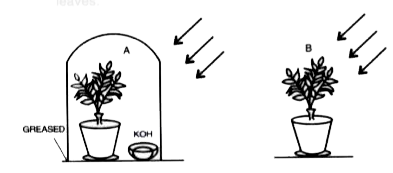
What hypothesis is being tested in this experiment?
View SolutionTwo healthy green plants were placed in the dark for 24 hours. They were then set-up as shown in the figure and left for 4 hours. Then a leaf was taken from each plant and the chlorophyll was removed from the leaves
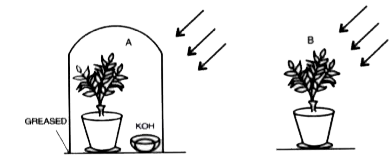
What would be the result of the final step?
View Solution
Knowledge Check
The forests of amierica, however slighted by man, must have been a great delight to god, for they wer the best he ever planted the whole continent was a garden, and from the beginning it seemed to tbe favored above all the other wild parks and gardens of the globe. [...] So they appeared a few cnturies ago when they were rajoicing in wildness. The indians with stone exes could do them no nore harm than could gnawing beavers and browsing moose. Even the fires of the indians and the fierce shattering lightning seemed to work together only for good in clearing sports here and there for smooth garden parairies, and openings for sunflowers seeking the light. But hwhen the steel axe of the white man rang out in the startled air their doom was sealed. Every tree heard the bodeful sound, and pillars of smoke gave the sign in the sky. I suppose we need not go mourning the buffaloes. In the nature of things they had to give place to better cattle, though the chang e might have be made without barbarous wickedness. Likewise many of nature's five hundred kinds of wild trees had to make way for orchards and conrfields. In the settlement and civilization of the country, bread m ore than timebr or beauty was wanted, and in the blindess of hunger, the early settlers claiming heaven as theri guide, regarded god's trees as only a larger king of pernicious weeds, extremely hard to get rid of. Accordingly, whth no eye to the future, these pious destroyers waged interminable forest wars, chips flew thick and fast, trees in their beauty fell crashing by mllions, smashed to confusion, and the smoke of their burning has been rising to heaven more than two hundred years. After the atlantic coast from Maine to Georgia had been mostly cleard and acorched into melancholy runins, the overflowing multitude of bread and money seekers poured over the Alleghenies into the fertile middle west, spreding ruthless devastation ever wider and farther over the rich valley of the Missippi and the vast shadowy pine region about the Great lakes. Thence still westward the invading horde of destroyers called settlers made its fiery way over the broad Rocky Mountains, felling and buring more fercely than ever, until at last it has reached the wild side of the continent, and entered the last of the great aboriginal foreast on the shores of the pacific. Surely, then ,it should not be wondered at that lovers of their country, bewailing its baldness, are now crying aloud, " save what is left of the forests" Clearing has surely now gone far enough, soon timber will be scarce, and not a grove will be left to rest in or pary in. the remnant protected will yield plenty of timber, a perennial harvest for every right use, without further diminution of its area, and will continue to cover the springs of the rivers that rise in the mountains and giveirrigating waters to the dry valleys at their feet, prevent wasting floods and be a blessing to everybody forever. Every other civilized nation in the word has been compelled to care for its forests, and so must we if wase and destruction are not to go on to the bitter end, leaving america as barren as palestine or spain. In its clamer moments in the midst of bewildering hunger and war and restless over-industry, Prussia has learned that the forest plays an important part in hman progress, and that the advance in civilization only makes it more indispensable. [...] so far our government has done nothing effective with its forests, though the best in the world, but is like a rich and foolish spendthrift who has inherited a magnificent estate in perfect order, and then has left his rich fields and meadows, forests and then has left his rich fields and meadows, forests and parks, to be sold and plundered and wasted at will, depending on their inexhaustible abundance. Now it is plain that the forests ae not inehaustible, and that quick measures must be taken if ruin is to be avoided. Muir's tone in the passage is best described as
Aurgent and earnestBarrogant and condescendingCoptimistic and cheerfulDhopeless and depressed
The diagram given below is a set up to demonstrate an experiment
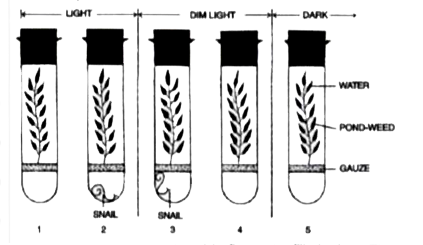
Pond-weed was placed in five water-filled tubes. The experiment was set-up as shown in the diagram. The tubes were then left for 24 hours
The tube in which the plant would survive for the shortest length of time is
View SolutionThe diagram given below is a set up to demonstrate an experiment
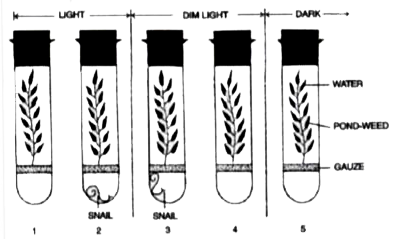
Pond-weed was placed in five water-filled tubes. The experiment was set-up as shown in the diagram. The tubes were then left for 24 hours
In which tube would you expect to find the plant with the least amount of starch?
View SolutionA potted plant was taken in order to prove a factor necessary for photosynthesis. The potted plant was kept in the dark for 24 hours. One of the leaves was covered with black paper in the centre. The potted plant was then placed in sunlight for a few hours.

During the starch test, why was the leaf: (1) boiled in water (2) boiled in methylated spirit
View SolutionThe diagram given below is a set up to demonstrate an experiment

Pond-weed was placed in five water-filled tubes. The experiment was set-up as shown in the diagram. The tubes were then left for 24 hours
The tube in which least carbon dioxide would be found is
View SolutionThe diagram given below is a set up to demonstrate an experiment
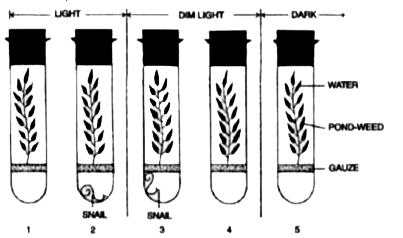
Pond-weed was placed in five water-filled tubes. The experiment was set-up as shown in the diagram. The tubes were then left for 24 hours
In which tube would you expect the greatest increase in dry weight to the pond-weed
View SolutionThe diagram below shows two test-tubos A and B. Test-tube A contains a green water plant Test-tube B contains both a groen water plant and a snail. Both test tubes are kept n sunlight Answer the questions that follow
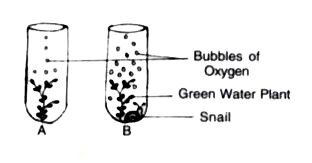
Give an example of a water plant that can be used in the above experiment.
View SolutionThe diagram given below is a set up to demonstrate an experiment
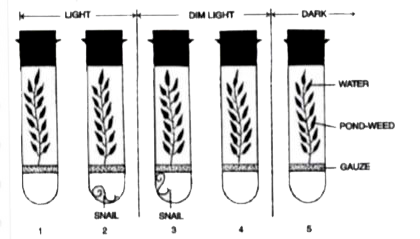
Pond-weed was placed in five water-filled tubes. The experiment was set-up as shown in the diagram. The tubes were then left for 24 hours
The tube in which most oxygen would be found is
View Solution
